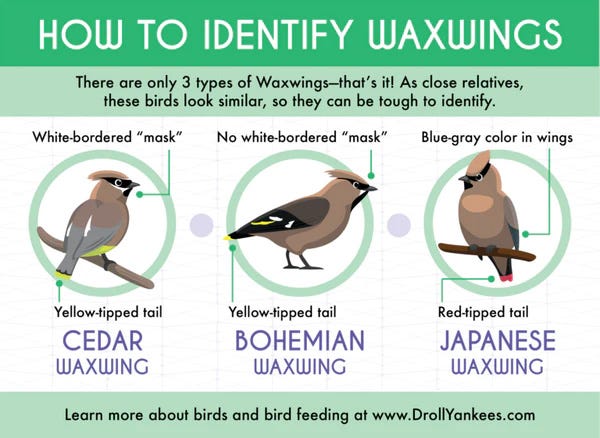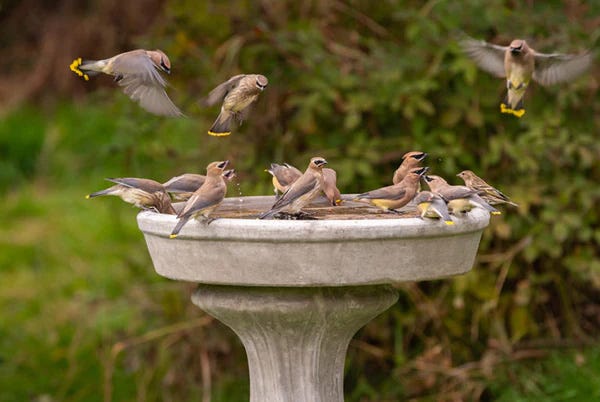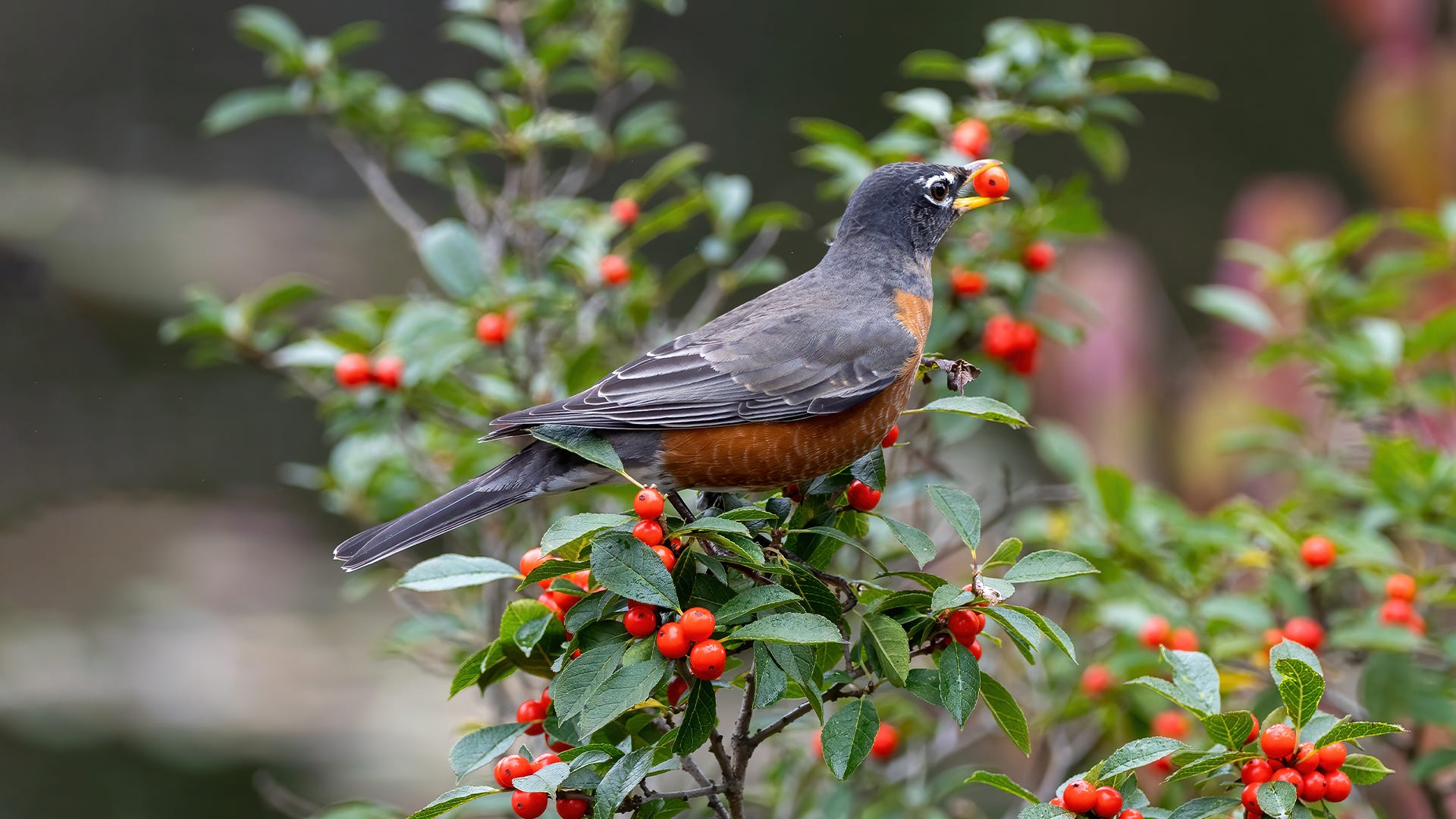
Few birds are as exciting to attract as waxwings, though they can be a challenge to entice to your yard. Understanding their unique needs is essential to welcome these bandit-masked songbirds. Cedar waxwings, bohemian waxwings and Japanese waxwings can all be attracted with similar tactics.
Types of Waxwings
There are only three types of waxwing species in the world:
Cedar Waxwing

The cedar waxwing (Bombycilla cedrorum) is the most familiar in North America. The bird is widespread from the boreal forests of Canada throughout the continental United States and into Mexico, with its southernmost winter range stretching to Panama and northern Colombia.
Cedar waxwings are easily recognized by their:
- Slender builds
- Jaunty crests
- Black masks with thin white borders
- Bright yellow tip on their tails
- Yellow wash on their bellies
- Yellow waxy tips on their secondary feathers
Bohemian Waxwing

The bohemian waxwing (Bombycilla garrulus) is the most widespread waxwing species. It is found in North America, Europe, and Asia. Despite their wide range, however, these waxwings are somewhat difficult to see since they prefer to stay in more northern habitats. They do not venture as far south as cedar waxwings.
Bohemian waxwings are slightly larger than cedar waxwings and are easy to identify by their:
- Brick-red patch underneath their tails
- Overall grayish underparts
- Overall darker faces without the white border on their masks
Japanese Waxwing

The Japanese waxwing (Bombycilla japonica) has the most restricted range of the three waxwing species. It is only found in eastern Asia from Japan to the Korean peninsula, eastern China, and a small portion of southeastern Russia.
These birds look similar to bohemian waxwings but have:
- A red rather than yellow tip on their tails
- Yellow wash on their underparts
- Distinctive blue-gray coloration in their wings
Despite their widespread ranges and physical differences, all three waxwings have similar preferences for food, water, and shelter. Birders who know how to meet those needs will have greater success attracting waxwings.
See also: How to Attract Blue Jays
Feeding Waxwings
Waxwings are primarily frugivores and fruit makes up most of their diet. Because these birds swallow their food whole, they prefer small fruits and berries. Adding a variety of fruit-bearing and berry-producing trees and shrubs to your landscape will provide abundant food for waxwings. Some of the best trees and shrubs to offer include:
- Blackberry
- Blueberry
- Cedar
- Cherry
- Dogwood
- Elderberry
- Grapevine
- Hackberry
- Holly
- Juniper
- Mountain Ash
- Mulberry
- Privet
- Viburnum
- Yew
2. Fill the Feeder with a Popular Seed
Whichever plants you choose, opt for cultivars that produce abundant fruit. Waxwings are voracious eaters and gorge whenever they find a food source.
Because these birds travel in flocks, they can quickly strip a tree or bush of all edible fruit. Planting multiple varieties with different fruiting times will ensure an ongoing food supply for hungry waxwings.
Waxwings don’t easily come to feeders, but they can be persuaded if you offer suitable foods in large, open platform or tray feeders where waxwing flocks can feel most comfortable. Cranberries, raisins, currants, chopped grapes, and small apple chunks may tempt waxwings. Another fun option is to create edible fruit and berry garlands that can be strung on trees for waxwings to find.
It is also important to note that waxwings do eat more than fruit. While they are fruit specialists, these birds eat a wide range of insects in spring and early summer when young hatchlings need extra protein for healthy growth. Minimizing insecticides during that time will give waxwings plenty of caterpillars, beetles, flies, and cicadas to eat before late season fruits begin to ripen.

Water for Waxwings
Waxwings may not come to feeders very easily, but they will happily visit bird baths. Large, broad basins are essential to accommodate waxwing flocks. The bath should be no more than 2-3 inches deep so the birds feel comfortable splashing about. Place the bird bath in a bright, sunny area so it can catch the attention of passing waxwings. Consider adding a dripper, bubbler, or wiggler for extra motion to make the bath more noticeable. In winter, a heated bird bath is essential so waxwings can find liquid water even during the most frigid cold snaps.
See also: 8 Things You Should Know Before Installing a BirdbathWaxwing Shelters
Because these birds stay in northern areas all winter, good shelter is essential to keep waxwings safe and comfortable. Cedar and maple trees are some of their preferred trees for nesting. Different evergreen trees and shrubs are best for year-round protection from icy winds and abundant snow. In spring, offering a suet cage filled with natural fibers such as fur, wool, and feathers may entice waxwings to nest nearby, particularly if there is still fruit remaining on local trees and shrubs.
See also: Please Don’t Give Birds These Nesting MaterialsFinding Waxwings in Your Yard
Waxwings are highly nomadic. Even birders who have everything right in their yard to welcome these charming birds may not enjoy predictable waxwing visits. It is important to stay alert for waxwings’ sudden visits, and listen carefully for their clear, musical voices and high-pitched notes. These birds rarely travel alone, and where one waxwing is spotted, it is likely an entire flock will follow. When one waxwing does arrive, however, watch its accompanying flock carefully—bohemian waxwings are often mixed in with flocks of cedar or Japanese waxwings. Birders may be surprised with more than one type of waxwing during each delightful visit!







